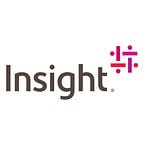Adopting a Modernized, Cloud-First Approach
By Carm Taglienti, Distinguished Engineer and Portfolio Director, Insight Enterprises
Organizations across industries are faced with a challenging business landscape, fighting tooth and nail to stay competitive while maximizing margins, optimizing operations and retaining top talent.
That requires leveraging the right services — with cloud computing at the heart of this conversation — in efficient ways. Cloud computing is a model for delivering IT services through web-based applications, rather than a direct connection to a server. This allows users to access data and applications from any connected device, reducing the need for local storage and processing power.
The benefits of cloud computing can be vast, ranging from cost-savings, enhanced collaboration, improved efficiency and increased agility and flexibility. Many organizations are taking note: according to a report from FORTUNE Business Insights, the global cloud computing market size is projected to grow from $480.04 billion in 2022 to $1.71 trillion by 2029 — a compound annual growth rate of 19.9%.
In our own digital transformation report conducted by Foundry, nearly half (49%) of IT and business leaders cited increasing cloud adoption via multicloud and hybrid cloud strategy was a top priority for their organization in 2023.
This significant cloud computing adoption helps illustrate how companies recognize it as a critical function for success. But that’s only achievable if cloud-consumption growth is strategic and deliberate. Without the right administration, rapid growth may lead to oversized workloads and mis-spent resources.
A pragmatic, cloud-first approach is critical for businesses seeking to improve their bottom line and stay ahead. Here’s what that looks like in practice.
Assess the ‘Cloud-Readiness’ of Operations
Much of the steps to cloud success comes from the initial groundwork laid during the first few phases of assessment and planning, which involves evaluating how ready an organization is for a migration. It takes a very close look at current IT operations, processes and people, with a particular focus on applications, as well as application workloads.
A workload may involve certain compute, network or storage needs and can require one or more databases. It might even involve other, interconnected applications. This is where organizations should start to determine which workload goes where in the cloud or on-premises. This is not always an easy task.
To do this, business and IT leaders need to ask critical questions like:
· What does this application depend on to operate? What base metrics can I collect to learn more?
· How much does this application workload cost to run now?
· If this workload moved to a public cloud, how often would users need to send data to it (or, more importantly, receive data from it)? How much data? How does that translate into cloud ingress/egress charges?
· What “cloud-to-on-premises” connectivity options and performance levels are needed for this workload in the cloud?
Addressing these questions can help organizations identify the workloads that are most “cloud-ready” and more effectively manage cost investments toward application modernization or optimization that may be required before certain legacy workloads can be shifted in the cloud. Organizations also will be better able to determine which workloads are better suited for hybrid cloud or continued, on-premises operations — at least for the short term.
Ensure Needs are Being Met
Once organizations understand which workloads can be transferred to the cloud, they can begin thinking about different proofs of concept. Done properly, these plans will serve as a critical roadmap to guide organizations smoothly toward success with cloud services.
However, with so many cloud services to choose from, organizations must be thoughtful about their consumption, or they run the risk of incurring significant costs. Suboptimal spend is a risk that organizations can run if they migrate workloads too quickly. Instead, businesses must efficiently utilize their cloud license portfolio so they can maximize their investments and gain the utility they need, without spending unnecessarily on redundant features.
After all, the most competitive businesses are ones that are agile and align their IT operations to meet their daily needs. Recently, Insight helped a major coffeehouse chain leverage Microsoft Azure to modernize its cloud operations. This business already utilized Azure for a host of benefits, but with a significant growth in its Azure subscriptions, the client saw an opportunity to reduce costs and take a more strategic approach to its cloud consumption. The outcome of these efforts resulted in more than $5M in annual savings across 300 subscriptions — a reduction by roughly 20% of the client’s annual Azure spend.
Going Live in a Disciplined Manner
All steps leading to this point should prepare an organization to now go live and migrate targeted production data and workloads to the cloud. By this stage, there should be a good handle on new roles and who has them, and how workloads will be secured, managed, and supported.
In case there are challenges or sudden changes in move schedules, established migration runbooks with rollback procedures should also be available for all parties involved in the migration. Throughout this process, organizations should conduct rigorous testing and validating.
IT transformation is a complex journey, and effectively navigating cloud is a key component and preparation is paramount. While the process may appear daunting for an unfamiliar organization seeking to wrap its arms around the cloud, it’s important to consider all the benefits a modernized-cloud model can offer.
Carm Taglienti is a Distinguished Engineer and solutions portfolio director at Insight, a Fortune 500 Solutions Integrator driving client success through digital transformation. Carm has more than 25 years of experience as a cloud computing, data science, data analytics and data management expert. As a principal cloud and AI architect for Insight, he focuses on cloud-based business solutions across multiple industries and technical domains. He also serves as an adjunct professor at Northeastern University Khoury College of Computer Sciences and the College of Professional Studies teaching graduate courses in data science, cloud computing and analytics.
